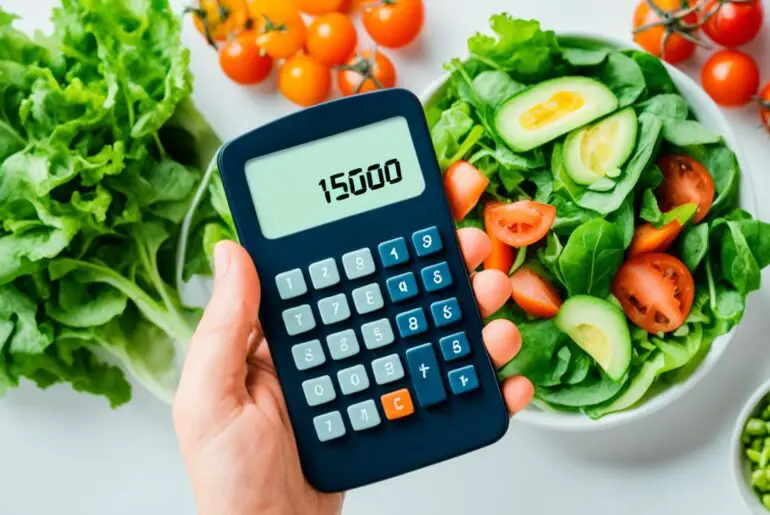Did you know that HCG Maintenance allows you to enjoy a wide variety of foods while maintaining your weight loss? Transitioning from Phase 2 to Phase 3 of the HCG Diet doesn’t mean you have to restrict yourself. In fact, there are plenty of delicious and nutritious options to choose from. Let’s explore the foods you can eat in HCG Maintenance and how they can support your weight stabilization journey.
Key Takeaways:
- During HCG Maintenance, you can incorporate a variety of proteins, including beef, chicken, seafood, pork, eggs, and dairy.
- Non-starchy vegetables like lettuce, peppers, cauliflower, broccoli, and cabbage are allowed in HCG Maintenance.
- Fruits in moderation, along with oils and fats like coconut oil, olive oil, butter, and nut oils can be part of the HCG Maintenance diet.
- Nuts and seeds can be consumed in moderation, providing a satisfying snack option.
- Optional dairy products like cheese, cream, and Greek yogurt can be included in the diet.
Protein Sources in HCG Maintenance
During the HCG Maintenance phase, a wide array of protein options are available to you. These include beef, chicken, seafood (fish, shrimp, crab, lobster, etc.), pork, eggs, and dairy. There are no restrictions on fat content or amounts, as your body is in a primarily Keto state. It’s essential to choose whole, unprocessed protein sources to ensure optimal nutrition and health.
When selecting protein sources for HCG Maintenance, it’s important to avoid overly sugared, salted, and preserved meats. Opt for organic, wild-caught, free-range, and grass-fed options whenever possible. These choices not only provide higher quality proteins but also support sustainable and humane farming practices.
Protein is a critical component of the HCG Maintenance phase as it helps maintain muscle mass and promotes satiety. Incorporating a variety of protein sources into your diet ensures that you receive a balanced and diverse range of essential amino acids, vitamins, and minerals.
Here are some approved protein options for HCG Maintenance:
- Beef: Choose lean cuts like steak, ground beef, and beef tenderloin.
- Chicken: Opt for skinless chicken breasts or thighs.
- Seafood: Enjoy fish, shrimp, crab, lobster, and other seafood rich in beneficial omega-3 fatty acids.
- Pork: Select lean cuts like tenderloin or pork chops.
- Eggs: Prepare eggs in various ways such as boiled, scrambled, or in omelets.
- Dairy: Incorporate full-fat dairy products like cheese, cream, and Greek yogurt (unsweetened) into your meals.
Remember, when choosing your protein sources, opt for whole, unprocessed options and try to avoid overly processed or packaged meats. By prioritizing high-quality proteins during HCG Maintenance, you can support your overall health and achieve successful weight stabilization.
| Protein Source | Benefits |
|---|---|
| Beef | Rich in essential nutrients and iron |
| Chicken | High-quality lean protein source |
| Seafood | Excellent source of omega-3 fatty acids |
| Pork | Provides essential vitamins and minerals |
| Eggs | Complete protein source with essential amino acids |
| Dairy | Offers calcium and probiotics for gut health |
Vegetables in HCG Maintenance

When following the HCG Maintenance phase, it’s essential to incorporate a variety of non-starchy vegetables into your diet. These vegetables not only provide essential nutrients but also help keep you feeling satisfied and full. By choosing colorful and nutrient-rich veggies, you can ensure a well-rounded and balanced eating plan during this phase.
Non-starchy vegetables with a glycemic index (GI) under 30 are approved for HCG Maintenance. This includes a wide range of options:
- Lettuce and greens
- Peppers
- Cauliflower
- Broccoli
- Cabbage
- Carrots
- Mushrooms
- Sprouts
- Radishes
- Tomatoes
- Onions
- Garlic
- Herbs
- Brussel sprouts
- Cucumber
- Asparagus
- Avocados
These vegetables not only add flavor and texture to your meals but also provide essential vitamins, minerals, and fiber. They can be enjoyed raw in salads, sautéed, roasted, or steamed as a side dish or incorporated into soups and stews.
The Importance of Non-Starchy Vegetables in HCG Maintenance
Incorporating non-starchy vegetables into your HCG Maintenance phase is crucial for several reasons. Firstly, these vegetables are low in carbohydrates and have a minimal impact on blood sugar levels, making them an excellent choice for weight maintenance. Secondly, they are rich in fiber, which aids in digestion and promotes overall gut health. Lastly, they are packed with essential vitamins and minerals that support optimal health and well-being.
Remember, variety is key when it comes to vegetables in HCG Maintenance. By including a wide range of colorful and nutrient-rich veggies in your meals, you ensure that your body gets a diverse array of essential nutrients.
During this phase, it’s important to avoid starchy vegetables that have a higher carbohydrate content. Examples of starchy vegetables to avoid include winter squash, green peas, corn, potatoes, and parsnips. These vegetables tend to have a higher glycemic index, which can impact blood sugar levels and hinder weight maintenance.
Comparison of HCG Maintenance Approved Vegetables
| Vegetable | Glycemic Index (GI) |
|---|---|
| Lettuce and greens | 10 |
| Peppers | 15 |
| Cauliflower | 15 |
| Broccoli | 15 |
| Cabbage | 10 |
| Carrots | 20 |
| Mushrooms | 10 |
| Sprouts | 15 |
| Radishes | 15 |
| Tomatoes | 15 |
| Onions | 10 |
| Garlic | 10 |
| Herbs | 5 |
| Brussel sprouts | 15 |
| Cucumber | 5 |
| Asparagus | 15 |
| Avocados | 10 |
Fruits in HCG Maintenance
All fruits play a role in a balanced diet, including during the HCG Maintenance phase. However, it’s important to exercise moderation when incorporating fruits into your meals. Consuming excessive amounts of fruit can hinder weight stabilization, so it’s crucial to be mindful of portion sizes.
For those on HCG Maintenance, opting for lower sugar fruits is ideal. These include apples, cherries, berries, melons such as honeydew and cantaloupe, kiwi, grapes, peaches, nectarines, apricots, and pomegranates. These fruits offer a flavorful and nutritious addition to your diet without causing significant spikes in blood sugar levels.
It’s advisable to steer clear of dried fruits and fruit juices during HCG Maintenance. These tend to have concentrated amounts of sugars, which can counteract the goals of the maintenance phase. Instead, focus on consuming whole fruits in their natural form, providing you with essential fiber and nutrients.
While fruits are generally a healthy choice, it’s important to note that bananas should be avoided until Phase 4 Maintenance. Bananas contain a higher starch and sugar content, which can interfere with effective stabilization during the earlier phases of the HCG program.
Remember, the key to successful HCG Maintenance is balance and moderation. By incorporating low-sugar fruits into your meals and snacks, you can enjoy a wide variety of flavors while sustaining your weight loss journey.
| Fruits in HCG Maintenance | Sugar Content (grams per 100g) | Recommended Portion Size |
|---|---|---|
| Apples | 10.3 | 1 medium-sized apple |
| Cherries | 12 | 10-12 cherries |
| Berries (strawberries, blueberries, raspberries) | 4-6 | 1 cup mixed berries |
| Melons (honeydew, cantaloupe) | 8-9 | 1 cup diced melon |
| Kiwi | 7.5 | 1 medium-sized kiwi |
| Grapes | 16 | 1 cup grapes |
| Peaches | 8 | 1 medium-sized peach |
| Nectarines | 8 | 1 medium-sized nectarine |
| Apricots | 3.2 | 2-3 apricots |
| Pomegranates | 13 | 1 medium-sized pomegranate |
The Benefits of Low-Sugar Fruits
Choosing low-sugar fruits during HCG Maintenance offers several advantages. These fruits provide essential vitamins, minerals, and antioxidants while contributing to overall digestive health. Their lower sugar content aids in maintaining stable blood sugar levels, which is especially important for dieters focused on weight stabilization.
Additionally, low-sugar fruits often contain a higher fiber content. Fiber promotes feelings of fullness and supports healthy digestion. By incorporating these fruits into your diet, you can curb cravings and maintain better control over your food intake.
Keep in mind that moderation is key when enjoying fruits during HCG Maintenance. Balancing your meal plan with a variety of nutritious foods, including low-sugar fruits, will help you maintain your weight loss success and overall well-being.
Oils and Fats in HCG Maintenance

When it comes to cooking during HCG Maintenance, incorporating healthy oils and fats is essential. These fats not only add flavor to your meals but also provide important nutrients for your body. Here are some approved oils and fats that you can use in your HCG Maintenance diet:
Preferred Options
Coconut oil, olive oil, and real butter are the preferred choices for cooking in HCG Maintenance. These oils and fats are not only delicious but also offer a range of health benefits. Coconut oil, for example, contains medium-chain triglycerides (MCTs) that can boost metabolism and support weight loss. Olive oil is rich in heart-healthy monounsaturated fats, while real butter adds a creamy richness to your dishes.
Nut and Seed Oils
In addition to coconut oil and olive oil, you can also use a variety of nut and seed oils in your HCG Maintenance cooking. Hazelnut, walnut, grapeseed, sesame, flax, and almond oils are all approved options. These oils not only provide healthy fats but also offer unique flavors to enhance your culinary creations.
Other Allowed Fats
While it’s important to avoid trans fats and artificial products like margarine and Crisco, there are still some fats that are allowed in HCG Maintenance. Bacon grease and cream, for example, can be used in moderation. However, it’s important to note that while these fats are allowed, it’s still advisable to use them sparingly to maintain a balanced diet.
When selecting oils and fats for your HCG Maintenance diet, it’s important to choose options that are made from healthy fats and avoid those made from genetically modified organisms (GMOs). Look for oils that are cold-pressed and minimally processed to ensure the highest quality and nutritional value.
“Incorporating healthy oils and fats into your HCG Maintenance diet not only adds flavor to your meals, but also provides important nutrients for your body.” – HCG Maintenance Expert
By incorporating these approved oils and fats into your HCG Maintenance cooking, you can enjoy flavorful meals while supporting your body’s nutritional needs. Remember to use these fats in moderation and focus on choosing high-quality, unprocessed options to maximize their health benefits.
Nuts and Seeds in HCG Maintenance
https://www.youtube.com/watch?v=InYQGpUcHg4
When it comes to snacks during HCG Maintenance, nuts and seeds can be a healthy and satisfying option. These crunchy and nutrient-dense treats provide a good source of protein, healthy fats, and fiber, making them a great addition to your diet. However, it’s important to choose the right nuts and seeds and consume them in moderation to stay within the guidelines of the HCG Maintenance phase.
Here are some HCG Maintenance approved nuts and seeds that you can enjoy:
- Almonds
- Walnuts
- Peanuts
- Pecans
- Coconut
- Hazelnuts
- Pistachios
- Chia seeds
These nuts and seeds are packed with essential nutrients, including healthy fats, vitamins, minerals, and antioxidants. They can provide a satisfying crunch and boost to your snacks and meals. However, it’s important to consume them in limited quantities as they are calorie-dense.
While most nuts and seeds are suitable for HCG Maintenance, it’s important to be cautious with certain varieties that have a higher starch content. Cashews, sesame seeds, pignoles (pine nuts), and sunflower seeds should be consumed in moderation as they contain more carbohydrates. As with any food in HCG Maintenance, portion control is key.
Remember, HCG Maintenance is about making healthy choices and maintaining your weight loss. Nuts and seeds can be a part of your healthy eating plan, but always enjoy them in moderation. Pair them with other approved foods to create well-balanced meals and snacks that support your HCG Maintenance goals.
Dairy in HCG Maintenance (optional)

During HCG Maintenance, you have the option to include dairy products in your diet. The key is to choose dairy options that are full-fat, unprocessed, and unsweetened. These dairy options can provide additional variety and flavor to your meals while still adhering to the guidelines of the HCG Maintenance phase.
Recommended Dairy Choices
When incorporating dairy into your HCG Maintenance diet, it’s best to opt for most full-fat, unprocessed, and unsweetened cheeses. These include varieties such as cheddar, Swiss, provolone, Gouda, and Parmesan. These cheeses can be enjoyed in moderation and can add a creamy, indulgent taste to your meals.
In addition to cheese, you can also include other dairy products such as half and half, whole milk, and cream. These can be used in small amounts as additions to your coffee, tea, or other recipes that call for dairy.
Another dairy option that is allowed during HCG Maintenance is Greek yogurt, but only the unsweetened full-fat varieties. Greek yogurt provides a good source of protein and can be enjoyed as a snack or used in recipes as a creamy base.
Avoid Skim or Low-Fat Dairy Products
While dairy is optional during HCG Maintenance, it’s important to avoid skim or low-fat dairy products. These products often contain added sugars and can interfere with the process of weight stabilization. To ensure the best results during HCG Maintenance, it’s recommended to choose full-fat dairy options instead.
Additionally, it’s advisable to steer clear of processed and artificial cheese products. These may contain additives and preservatives that can be detrimental to your health and can hinder your progress during HCG Maintenance.
By choosing high-quality, full-fat, unprocessed, and unsweetened dairy options, you can enjoy the benefits of dairy while on the HCG Maintenance diet.
| Dairy Option | Recommended |
|---|---|
| Full-Fat, Unprocessed Cheese | ✓ |
| Half and Half | ✓ |
| Whole Milk | ✓ |
| Cream | ✓ |
| Greek Yogurt (Unsweetened, Full-Fat) | ✓ |
| Skim or Low-Fat Dairy Products | ✗ |
| Processed and Artificial Cheese Products | ✗ |
Sample Diet Menus for HCG Maintenance Phase 3 (1st 3 Weeks)

During the first 3 weeks of HCG Maintenance Phase 3, it’s important to follow a diet plan that avoids sugars and starches. Incorporating sample diet menus can provide inspiration and ideas for delicious and nourishing meals during this phase.
-
Morning:
Start your day with a protein-packed breakfast to fuel your body. Pair scrambled eggs with Greek yogurt and mixed berries for a satisfying and nutritious meal.
-
Afternoon:
For lunch, enjoy a bun-less burger topped with lettuce, tomato, and onion. Accompany it with a side salad consisting of mixed greens, cucumbers, and bell peppers, drizzled with a light vinaigrette dressing.
-
Evening:
Get creative with dinner by making taco night healthier. Use large lettuce leaves as a substitute for tortillas and fill them with seasoned grilled chicken or lean ground beef, accompanied by sautéed bell peppers and onions. Top with fresh salsa and a dollop of Greek yogurt for a creamy and flavorful touch.
-
Snacks:
Keep your energy levels steady throughout the day with nutritious snacks. Enjoy low-sugar fruits like berries or a small apple, a handful of unsalted nuts (almonds, walnuts, or pistachios), or a protein-rich snack bar.
By following these sample diet menus, you can adhere to the guidelines of HCG Maintenance Phase 3 while enjoying a variety of delicious and satisfying meals. Remember to choose whole, unprocessed ingredients and prioritize nutrient-rich foods to support your overall health and weight stabilization.
| Meal | Menu |
|---|---|
| Morning | Scrambled eggs with Greek yogurt and berries |
| Afternoon | Bun-less burger with side salad |
| Evening | Lettuce-wrapped tacos with grilled chicken/lean ground beef and sautéed peppers and onions |
| Snacks | Low-sugar fruits, unsalted nuts, or protein-rich snack bar |
Conclusion
The HCG Maintenance phase offers a wider variety of food options compared to the previous phases of the HCG diet. To ensure successful weight stabilization, it is important to choose whole, unprocessed foods and steer clear of sugary and processed products. Incorporating protein sources, non-starchy vegetables, fruits in moderation, healthy oils and fats, nuts and seeds, and optional dairy products into your diet can provide a well-rounded and satisfying eating plan.
Following the HCG Maintenance guidelines, you can enjoy a range of proteins like beef, chicken, seafood, pork, eggs, and dairy. Non-starchy vegetables such as lettuce, peppers, cauliflower, broccoli, and cabbage are also allowed. Enjoy fruits in moderation, along with healthy oils and fats like coconut oil, olive oil, and nut oils. Snack on nuts and seeds, and optionally include dairy products like cheese and Greek yogurt.
Sample diet menus can serve as a helpful resource during the first three weeks of the HCG Maintenance phase. These menus can provide inspiration and ideas for meals that align with the guidelines. Remember to listen to your body’s hunger and fullness cues, and adjust your portions accordingly. Ultimately, finding a balance between satisfying your cravings and nourishing your body will contribute to successful weight maintenance on the HCG diet.
FAQ
What foods can I eat during HCG Maintenance?
During HCG Maintenance, you can enjoy a variety of proteins such as beef, chicken, seafood, pork, eggs, and dairy. Non-starchy vegetables like lettuce, peppers, cauliflower, broccoli, and cabbage are also allowed. Fruits in moderation, along with oils and fats like coconut oil, olive oil, butter, and nut oils, can be incorporated into the diet. Nuts and seeds, as well as dairy products like cheese, cream, and Greek yogurt, are optional.
What are the protein sources allowed in HCG Maintenance?
Protein sources allowed in HCG Maintenance include beef, chicken, seafood (fish, shrimp, crab, lobster, etc.), pork, eggs, and dairy. It is recommended to choose whole, unprocessed options and avoid overly sugared, salted, and preserved meats. Opt for organic, wild-caught, free-range, and grass-fed options whenever possible.
Which vegetables can I eat during HCG Maintenance?
Non-starchy vegetables with a glycemic index (GI) under 30 are allowed in HCG Maintenance. This includes lettuce and greens, peppers, cauliflower, broccoli, cabbage, carrots, mushrooms, sprouts, radishes, tomatoes, onions, garlic, herbs, Brussel sprouts, cucumber, asparagus, and avocados. Starchy vegetables like winter squash, green peas, corn, potatoes, and parsnips should be avoided during this phase.
Can I have fruits during HCG Maintenance?
All fruits can be consumed in moderation during HCG Maintenance. However, caution should be exercised with portions, as some dieters may have trouble stabilizing if they eat too much fruit. Lower sugar fruits like apples, cherries, berries, melons (honeydew, cantaloupe), kiwi, grapes, peaches, nectarines, apricots, and pomegranates are recommended. Dried fruits and fruit juices should be avoided due to their concentrated sugars. Bananas should be avoided until Phase 4 Maintenance due to their starch and sugar content.
What oils and fats can I use in HCG Maintenance?
Healthy oils and fats that can be used in HCG Maintenance include coconut oil, olive oil, and real butter. Other acceptable oils include nut and seed oils such as hazelnut, walnut, grapeseed, sesame, flax, and almond. Bacon grease and cream are also allowed. It’s important to avoid trans fats and artificial products like margarine and Crisco. Choose oils made from healthy fats and avoid those made from GMO ingredients.
Can I have nuts and seeds during HCG Maintenance?
Many nuts and seeds can be consumed in moderation during HCG Maintenance. Almonds, walnuts, peanuts, pecans, coconut, hazelnuts, pistachios, and chia seeds are all approved options. However, caution should be exercised with cashews, sesame seeds, pignoles (pine nuts), and sunflower seeds due to their higher starch content. It’s important to note that all nuts and seeds should be consumed in limited quantities.
Can I have dairy products in HCG Maintenance?
Full-fat dairy products are optional during HCG Maintenance. It’s recommended to choose most full-fat, unprocessed, unsweetened cheeses. Half and half, whole milk, and cream can also be consumed. Greek yogurt, but only the unsweetened full-fat varieties, is allowed. It’s important to avoid skim or low-fat dairy products, as the milk sugars can interfere with stabilization. Processed and artificial cheese products should be avoided as well.
Yes, here are some sample diet menus for the first 3 weeks of HCG Maintenance Phase 3:
– Protein-based breakfast: Eggs with Greek yogurt and berries
– Protein-focused lunch: Bun-less burgers with a side salad
– Keto-friendly dinner: Taco night using large lettuce leaves instead of tortillas
– Snacks: Fruits, nuts, and healthy protein bars
Remember to customize your meals based on your dietary preferences and follow the HCG Maintenance guidelines for successful weight stabilization.




